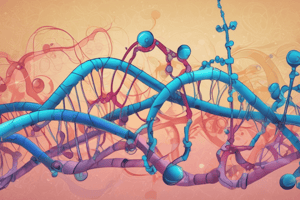Podcast
Questions and Answers
What term describes how cells convert DNA into proteins?
What term describes how cells convert DNA into proteins?
- Protein translation (correct)
- Gene transcription
- Chromosomal rearrangement
- Cell differentiation
How are dominant traits inherited?
How are dominant traits inherited?
- By only affecting certain organisms
- By being expressed with one gene copy (correct)
- By skipping generations
- By requiring two copies of the gene
Which of the following best describes Mendel's laws?
Which of the following best describes Mendel's laws?
- Laws that regulate the expression of recessive traits
- Laws that govern how proteins are synthesized from DNA
- Laws that explain how genes are passed from parents to offspring (correct)
- Laws that describe the movement of chromosomes during cell division
In a Punnett square, what do the letters on the outside of the square represent?
In a Punnett square, what do the letters on the outside of the square represent?
When two heterozygous individuals mate for a dihybrid trait, what percentage of their offspring is expected to be homozygous recessive for both traits?
When two heterozygous individuals mate for a dihybrid trait, what percentage of their offspring is expected to be homozygous recessive for both traits?
What term describes an organism having two identical alleles for a particular gene?
What term describes an organism having two identical alleles for a particular gene?
What is the main purpose of Punnett squares in genetic studies?
What is the main purpose of Punnett squares in genetic studies?
In a dihybrid cross involving flower color (red vs white) and petal shape (round vs narrow), how many different phenotypes can be expected?
In a dihybrid cross involving flower color (red vs white) and petal shape (round vs narrow), how many different phenotypes can be expected?
What does it mean if an organism is homozygous for a specific trait?
What does it mean if an organism is homozygous for a specific trait?
In a genetic cross between two heterozygous parents (GgYy), what is the probability of producing an offspring with the genotype GgYy?
In a genetic cross between two heterozygous parents (GgYy), what is the probability of producing an offspring with the genotype GgYy?
Which Mendel's law states that each trait is controlled by two forms, one dominant and one recessive?
Which Mendel's law states that each trait is controlled by two forms, one dominant and one recessive?
What characteristic distinguishes heterozygous individuals from homozygous individuals?
What characteristic distinguishes heterozygous individuals from homozygous individuals?
Flashcards are hidden until you start studying
Study Notes
Genetics
Genetics is the study of genetic information and how it determines characteristics and traits within an organism. It is a complex field that explores how genes influence development, health, and evolution. Here we will discuss some key concepts in genetics, including gene expression, inheritance patterns, Mendel's laws, Punnett squares, dihybrids, homozygous, and heterozygous.
Gene Expression
Gene expression refers to the process by which cells convert DNA into proteins. This process involves transcription and translation, where genetic information from DNA is translated into specific protein sequences. Understanding gene expression is crucial for understanding how genes control biological processes in living organisms.
Inheritance Patterns
Inheritance patterns describe how inherited traits are passed down through generations. These patterns can be determined using various methods such as pedigree analysis and linkage mapping. Two common patterns are dominant and recessive inheritance. Dominant traits are expressed even if only one copy of the gene is present, while recessive traits require two copies of the gene.
Mendel's Laws
Mendel's laws are fundamental principles in genetics, named after Gregor Mendel who first proposed them based on his experiments with pea plants. These laws state that:
- Traits appear in pairs
- Each parent passes half of its genes onto each offspring (the law of segregation)
- Each trait has two forms, one dominant and one recessive (the law of independent assortment).
Punnett Squares
Punnett squares are mathematical diagrams used to predict the possible outcomes of genetic crosses between two individuals. They help determine probabilities of inheriting certain traits based on whether they are dominated, recessive, or both. By filling in the squares with the different alleles for each trait, you can calculate the likelihood of obtaining certain combinations.
Dihybrid Crosses
A dihybrid cross is a type of genetic crossing experiment involving organisms with two pairs of alleles for different traits. For example, a cross between two individuals differing in flower color (red vs white) and petal shape (round vs narrow) would result in four possible phenotypes (color, shape): red round, red narrow, white round, and white narrow. The proportions of these phenotypes can be predicted using Punnett squares.
Homozygous vs Heterozygous
Homozygous refers to an organism having two identical copies of a gene for a particular trait, while heterozygous individuals have different versions (alleles) of the same gene. For example, if we consider a simple genetic crossing experiment with pea plants where one plant has dominant green seeds (gg) and another has recessive yellow seeds (yy), their offspring could either be homozygous dominant (GG or gg) or heterozygous (Gg). In the case of a dihybrid cross, there are four possible genotypes: GgYy, GgYy, GgYY, and GgYY. Understanding these concepts is vital for understanding inheritance patterns and predicting outcomes in genetic crosses.
Studying That Suits You
Use AI to generate personalized quizzes and flashcards to suit your learning preferences.




